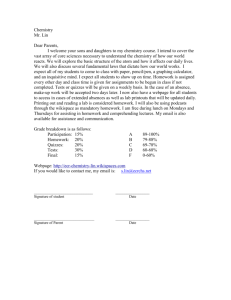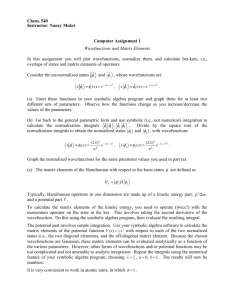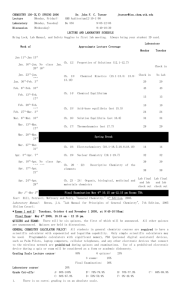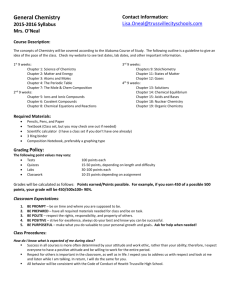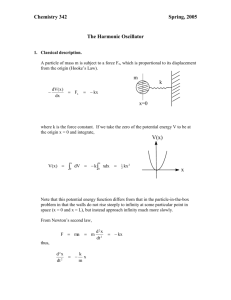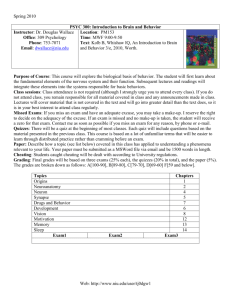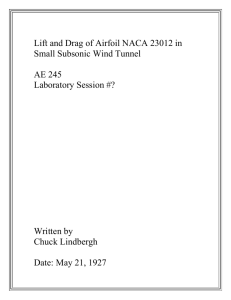Syllabus327
advertisement
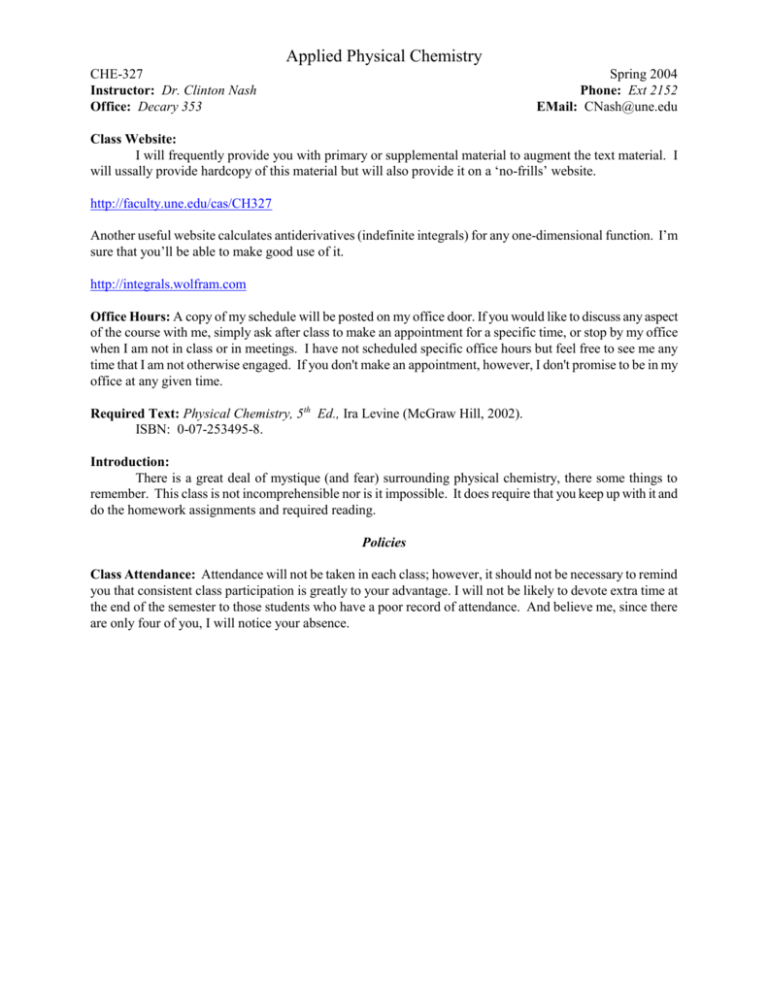
Applied Physical Chemistry CHE-327 Instructor: Dr. Clinton Nash Office: Decary 353 Spring 2004 Phone: Ext 2152 EMail: CNash@une.edu Class Website: I will frequently provide you with primary or supplemental material to augment the text material. I will ussally provide hardcopy of this material but will also provide it on a ‘no-frills’ website. http://faculty.une.edu/cas/CH327 Another useful website calculates antiderivatives (indefinite integrals) for any one-dimensional function. I’m sure that you’ll be able to make good use of it. http://integrals.wolfram.com Office Hours: A copy of my schedule will be posted on my office door. If you would like to discuss any aspect of the course with me, simply ask after class to make an appointment for a specific time, or stop by my office when I am not in class or in meetings. I have not scheduled specific office hours but feel free to see me any time that I am not otherwise engaged. If you don't make an appointment, however, I don't promise to be in my office at any given time. Required Text: Physical Chemistry, 5th Ed., Ira Levine (McGraw Hill, 2002). ISBN: 0-07-253495-8. Introduction: There is a great deal of mystique (and fear) surrounding physical chemistry, there some things to remember. This class is not incomprehensible nor is it impossible. It does require that you keep up with it and do the homework assignments and required reading. Policies Class Attendance: Attendance will not be taken in each class; however, it should not be necessary to remind you that consistent class participation is greatly to your advantage. I will not be likely to devote extra time at the end of the semester to those students who have a poor record of attendance. And believe me, since there are only four of you, I will notice your absence. Exams/Quizzes: Unannounced quizzes on assigned material may be given at any time, honestly this option will be exercised only if I get the feeling that the class has been ‘dogging it’ . There will be three hour exams to be held on the evenings of February 17th, March 25th, and April 22nd. If you have a conflict with one or more of these dates, please let me know. Problem Assignments: Most of the learning you will do in this course will come from reading and engaging (i.e. doing) the problem sets. I have written some of these and some will be taken from the book. In any case, it is important to do all of them. The problem sets will be turned in and graded and collectively are worth a substantial fraction of the points available in the course. Oral Exam: You will be expected to give an oral presentation to the class on a P-Chem topic of your choice. These presentations will be conducted the last week of the semester and you will be expected to incorporate primary physical chemistry literature in your work as well as any other material you might wish to include. Time Commitments: This is a high-level undergraduate science course! You should plan on spending at least 3 hours outside of class (exclusive of test preparation time) on this course's material for each hour of lecture time. Keep up with the material on a daily basis; if you fall behind, it will be hard to catch up. Evaluation: Course grades will be determined by the total number of points accumulated, based on the following approximate distribution: Hour Exams, 2 @ 100 pts each Problem Sets/Quizzes Oral Exam TOTAL (approx) 200 200 50 450 To estimate your current course grade at any point during the semester, simply divide your total accumulated points by the total possible points at that time (divide lab-related points by two before adding). All graded work will indicate the earned points and the total possible points. Grades will be assigned based on the typical distribution: 90-100% = A; 80-89% = B, 70-79% = C; 60-69% = D; <60% = F. Please note that your lab score is scaled to the proportion of lab points you earn (from lab quizzes and reports) relative to the total number possible. Yada, Yada, Yada..... Getting Help: Your best resources for help in this class will be (1) me and (2) each other. Please do not hesitate to contact me and ask me any question that you like. I also strongly suggest that unless I tell you otherwise you folks work together on the class material. Some of it will involve some “brain stretches” and the more you work together, the better you all will do. Comment on Cheating: No cheating of any sort will be tolerated. Note especially that plagiarism, the theft of ideas, will be severely penalized. Plagiarism will carry a penalty of complete loss of credit on the assignment, whether plagiarized from another student or a printed source, and may result in university disciplinary action. Anyone caught cheating on an exam or quiz will receive a grade of 0. Physical Chemistry CHE 327 Spring 2004 Course Outline 42 Lectures Approximate Schedule of Topics Date (week of) Jan 12 (2) (begins W.) Jan 19 (2) No class M Jan 26 (3) (MLK-no class M.) Feb 2 (3) Feb 9 (3) Feb 16 (3) Feb 23 (3) March 1 (3) March 8 (3) Mar 15 (3) Mar 22 (3) March 29 Apr 6 (3) Apr 13 (3) Apr 20 (3) Apr 27(3) Apr 29 (1) Chapter(s) Section 1: Quantum Mechanics and Spectroscopy Chapters 18,19,20,21 Free particle, DeBroglie Relationship, Wave-Particle Duality, Electron Microscopy, momentum Wavefunctions, operators, eigenvalue equations, the origin of quantization, time indepdendant wavefunctions, time dependent wavefunctions (revisit uncertainty principal, 1D particle in a box, 2D particle in a box, degeneracy, particle scattering Intro to angular momentum, particle on a ring, intro to rotational spectoscopy, electron spin, electron spin-wavefunctions, nuclear spin, NMR, ESR, two-state partition functions particle on a sphere, spherical harmonics, rotational (microwave) spectroscopy, angular momentum in 3D. Harmonic oscillator wavefunction, introduction to vibrational spectroscopy (IR RAMAN), tunneling, kinetic isotope effect, classical vs quantum barrier penetration vibration in polyatomic molecules. Spherical harmonics revisited, hydrogen-like wavefunctions, radial and angular expectation values, radial moments, Heisenberg uncertainty principle revisited multielectron atomic wavefunctions, spin-functions, atomic states, antisymmetry and Pauli exclusion principle hydrgen molecule ion, introductions to potential energy surfaces, molecular orbital approach, valence bond approach multi-electron molecular wavefunctions, fluorescence vs phosforescence selection rules and symmetry collections of molecules, reintroduction of (micro)canonical partition function, statistical interpretation of energy, enthalpy, and entropy, classical thermodynamic interpretation of energy, enthalpy, and entropy, constant heat capacities, a new interpretation of temperature Gibbs free energy and equilibrium from classical and statistical interpretations, derivation and microscopic meaning of equilibrium constants from derivation of equilibrium contants from partition functions from canonical partition function Transition state theory, Gibbs free energy of activation, relationship with Ahrennius activation energy, stearic effects (relationship to entropy of activation), general derivation of rate constants from partition functions. microscopic interpretation of phase equilibrium, semiempirical potential models (lennard jones, morse, buckingham), virial coefficients of real gasses wrap-up and therapy
